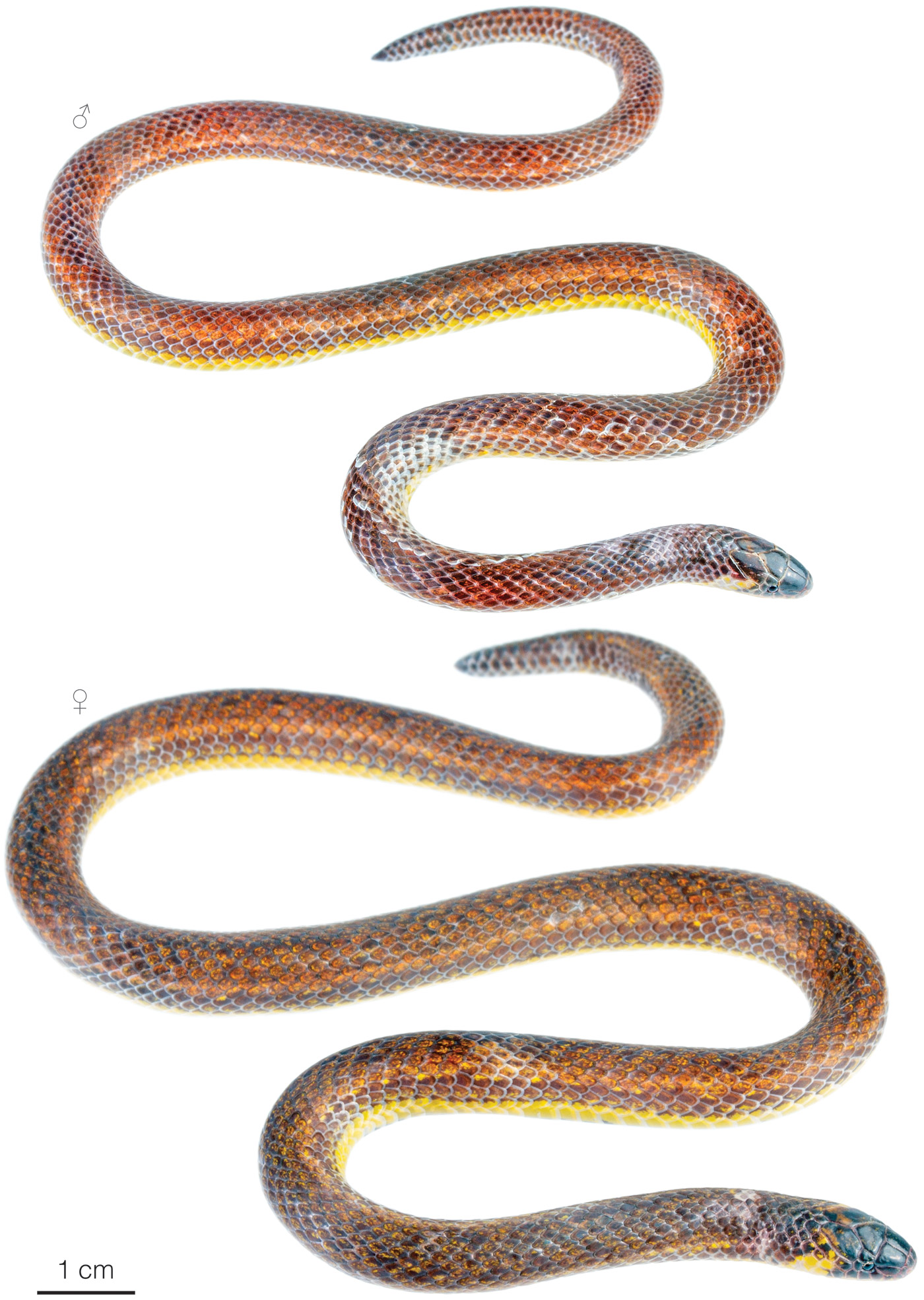Published February 17, 2024. Open access. | Purchase book ❯ |
Discovery Ground Snake (Atractus discovery)
Reptiles of Ecuador | Serpentes | Colubridae | Atractus discovery
English common name: Discovery Ground Snake.
Spanish common name: Tierrera de Discovery.
Recognition: ♂♂ 31.2 cmMaximum distance from the snout to the tip of the tail. Snout–vent length=28.4 cm. ♀♀ 35.2 cmMaximum distance from the snout to the tip of the tail. Snout–vent length=32.8 cm..1 Atractus discovery differs from other co-occurring snakes by having a round head similar in width to the neck, small eyes, uniformly dark brown dorsum with faint black speckling, and a unique ventral coloration (Fig. 1).1 The ventral surfaces are bright yellow with a conspicuous blackish longitudinal stripe.1 In the eastern slopes of the Ecuadorian Andes, the only other ground snakes having a similar ventral coloration are A. duboisi and A. orcesi. Atractus discovery can easily be differentiated from these two by having 17/17/17, instead of 15/15/15, dorsal scale rows.1 Additionally, A. discovery does not co-occur with other members of its genus.1 Males of the Discovery Ground Snake differ from females by being smaller and having a comparatively longer tail.1

Figure 1: Individuals of Atractus discovery from Amaluza, Azuay province, Ecuador.
Natural history: Atractus discovery is an extremely rare semi-fossorial snake known only from three specimens that were found in open areas adjacent to the forest border.1 One found was crawling at ground level at around 7:30 pm. It was crossing a series of cement stairs. The other two were found during a cloudy day, buried 15–40 cm under soft soil at the border between a graveyard, pastures, and remnants of native vegetation.1 Based on what is known about other ground snakes, the diet in this species probably includes earthworms and slugs.2,3 When handled, these ground snakes roll into a defensive ball posture and try to poke with their sharp tail-tip.4
Conservation: Data Deficient There is inadequate information to make an assessment of extinction risk..1 Atractus discovery is proposed to be included in this category because the species belongs to a poorly studied genus of snakes and is known only from three specimens collected recently in a single river valley (Río Paute) in the Amazonian slopes of the Ecuadorian Andes. In addition to the presence of a system of major hydroelectric dams in this valley, most of the native cloud forest habitat in the area has been converted to pastures. However, there is insufficient data to estimate whether the species is restricted to the immediate environs of the type locality or if it is widely distributed along the unexplored cloud forests of the adjacent Sangay National Park.
Distribution: Atractus discovery is known only from two localities (Arenales and Amaluza) on each side of the Río Paute, in the Ecuadorian provinces Azuay and Morona Santiago (Fig. 2). The airline distance between the two localities is 2.6 km.

Figure 2: Distribution of Atractus discovery in Ecuador. The star corresponds to the type locality: Amaluza, Azuay province, Ecuador.
Etymology: The name Atractus, which is a latinization of the Greek word άτρακτος (=spindle),5–7 probably refers to the fact that snakes of this genus have a uniform width throughout the body and a narrow tail, resembling an antique spindle used to spin fibers. The specific epithet discovery honors ‘The Explorers Club Discovery Expedition Grants’ initiative, a program seeking to foster scientific understanding for the betterment of humanity and all life on Earth and beyond. The grant program funded the expedition that resulted in the discovery of this new species of snake.
See it in the wild: Although only three individuals of Atractus discovery have ever been recorded, this species is presumed to be locally abundant at type locality, where individuals may be found by digging in areas of soft soil near remnants of native vegetation.
Autor and photographer: Alejandro ArteagaaAffiliation: Fundación Khamai, Reserva Arlequín, Ecoruta Paseo del Quinde km 56, Santa Rosa de Mindo, Pichincha 171202, Ecuador.
How to cite? Arteaga A (2024) Discovery Ground Snake (Atractus discovery). In: Arteaga A, Bustamante L, Vieira J (Eds) Reptiles of Ecuador: Life in the middle of the world. Available from: www.reptilesofecuador.com. DOI: 10.47051/SULE5336
Literature cited:
- Arteaga A, Quezada A, Vieira J, Guayasamin JM (2022) Leaving no stone unturned: three additional new species of Atractus ground snakes (Serpentes, Colubridae) from Ecuador discovered using a biogeographical approach. ZooKeys 1121: 175–210. DOI: 10.3897/zookeys.1121.89539
- Cisneros-Heredia DF (2005) Report of molluscivory in Atractus carrioni Parker, 1930. Herpetozoa 18: 185–186.
- Balestrin RL, Di-Bernardo M, Moreno AG (2007) Feeding ecology of the neotropical worm snake Atractus reticulatus in southern Brazil. The Herpetological Journal 17: 62–64.
- Field notes, Reptiles of Ecuador book project.
- Woodward SP, Tate R (1830) A manual of the Mollusca: being a treatise on recent and fossil shells. C. Lockwood and Company, London, 750 pp.
- Beekes R (2010) Etymological dictionary of Greek. Brill, Boston, 1808 pp.
- Duponchel P, Chevrolat L (1849) Atractus. In: d’Orbigny CD (Ed) Dictionnaire universel d’histoire naturelle. MM. Renard, Martinet et Cie., Paris, 312.